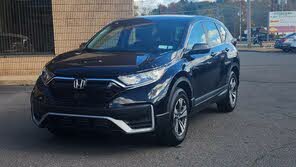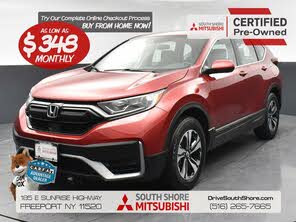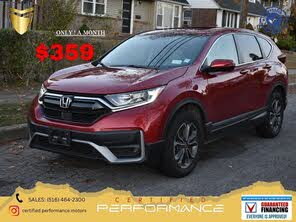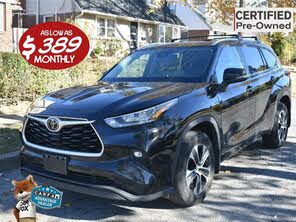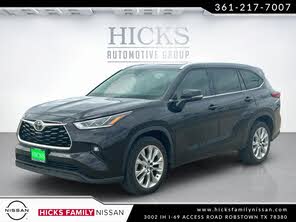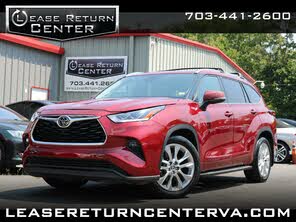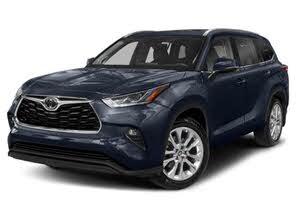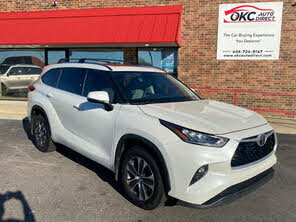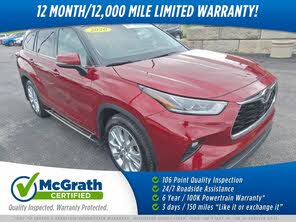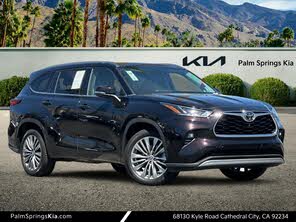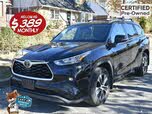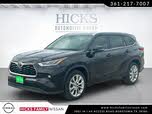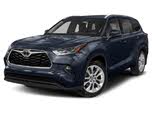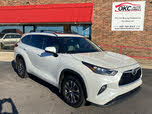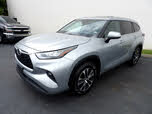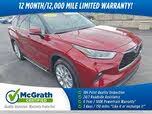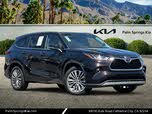2021 Honda CR-V vs 2020 Toyota Highlander
Overview | |
MSRP$34,600 | MSRP$25,350 |
Average price$30,412 | Average price$25,743 |
Listings539 | Listings1664 |
Ratings & Reviews | |
User Reviews | User Reviews |
Expert reviews7.7 out of 10 | Expert reviews7.8 out of 10 |
Pros
| Pros
|
2020 Toyota Highlander Reviews SummaryMidsize three-row SUVs are all spacious and powerful, but only the Toyota Highlander reaches the premium threshold for passenger comfort. Redesigned for 2020, the Highlander's revised styling and technology are secondary to its silent operation, soft ride, and cosseting interior. The upper trims feel and drive just like a Lexus, without the upcharge. There is nothing exciting about a Highlander, and yet, there is no other SUV in the $35,000 to $50,000 range that feels so effortless and tranquil. | |
2021 Honda CR-V Reviews SummaryEven in a grim year, Honda is selling a staggering number of CR-Vs. The CR-V is the best-selling Honda by far. It’s also the second best-selling compact SUV, just behind the Toyota RAV4. And it's the fifth best-selling vehicle in the U.S., and if you take out all the commercial sales of full-size pickups it’s one of the two best-selling vehicles year in and year out. So it’s hard to argue against the CR-V formula. Honda’s been at this almost as long as crossovers have been a thing, launching the CR-V in 1997—a year after the RAV4 debuted. The funny thing is, aside from sales volume, there’s only one thing the CR-V particularly excels at. Aesthetics are subjective, but it would be hard to argue the CR-V is the best looking vehicle in its class. It’s not the cheapest. It’s not the best equipped, especially at the middle to lower trim levels. It’s not the fastest, nor is it the quietest, or the most fuel efficient. It’s not even the most reliable, showing up nowhere in J.D. Power's Most Reliable list. So what makes it so appealing to American consumers? Let’s see if we can figure that out. | |
No video found | |
Popular Features & Specs | |
Engine3.5L 295 hp V6 | Engine1.5L 190 hp I4 |
Drive TrainFWD | Drive TrainFWD |
Seating Capacity8 | Seating Capacity5 |
Horsepower295 hp @ 6600 rpm | Horsepower190 hp @ 5600 rpm |
MPG City20 | MPG City28 |
MPG Highway28 | MPG Highway34 |
Engine | |
Engine Name3.5L 295 hp V6 | Engine Name1.5L 190 hp I4 |
Torque263 lb-ft @ 4700 rpm | Torque179 lb-ft @ 2000 rpm |
Horsepower295 hp @ 6600 rpm | Horsepower190 hp @ 5600 rpm |
DrivetrainFWD | DrivetrainFWD |
Fuel Economy | |
MPG City20 | MPG City28 |
MPG Highway28 | MPG Highway34 |
Interior | |
Seating Capacity8 | Seating Capacity5 |
Safety | |
Front Crash Overall4 | Front Crash Overall5 |
Side Crash Overall5 | Side Crash Overall5 |
Dimensions & Capacity | |
Cargo Space16.0 cu ft | Cargo Space39.2 cu ft |
Curb Weight4145 lbs | Curb Weight3337 lbs |
Height68.1 in | Height66.1 in |
Length194.9 in | Length182.1 in |
Width76.0 in | Width73.0 in |
Wheelbase112.2 in | Wheelbase104.8 in |
Maximum Payload1685 lbs | Maximum Payload1358 lbs |
Number of doors4 | Number of doors4 |
Maximum Towing Capacity5000 lbs | Maximum Towing Capacity1500 lbs |
Overview | ||
MSRP | $34,600 | $25,350 |
Average price | $30,412 | $25,743 |
Listings | ||
Ratings & Reviews | ||
User reviews | ||
Expert reviews | 7.7 out of 10Read full review | 7.8 out of 10Read full review |
Pros & cons | Pros
| Pros
|
Summary | Midsize three-row SUVs are all spacious and powerful, but only the Toyota Highlander reaches the premium threshold for passenger comfort. Redesigned for 2020, the Highlander's revised styling and technology are secondary to its silent operation, soft ride, and cosseting interior. The upper trims feel and drive just like a Lexus, without the upcharge. There is nothing exciting about a Highlander, and yet, there is no other SUV in the $35,000 to $50,000 range that feels so effortless and tranquil. | Even in a grim year, Honda is selling a staggering number of CR-Vs. The CR-V is the best-selling Honda by far. It’s also the second best-selling compact SUV, just behind the Toyota RAV4. And it's the fifth best-selling vehicle in the U.S., and if you take out all the commercial sales of full-size pickups it’s one of the two best-selling vehicles year in and year out. So it’s hard to argue against the CR-V formula. Honda’s been at this almost as long as crossovers have been a thing, launching the CR-V in 1997—a year after the RAV4 debuted. The funny thing is, aside from sales volume, there’s only one thing the CR-V particularly excels at. Aesthetics are subjective, but it would be hard to argue the CR-V is the best looking vehicle in its class. It’s not the cheapest. It’s not the best equipped, especially at the middle to lower trim levels. It’s not the fastest, nor is it the quietest, or the most fuel efficient. It’s not even the most reliable, showing up nowhere in J.D. Power's Most Reliable list. So what makes it so appealing to American consumers? Let’s see if we can figure that out. |
Video | No video found | |
Popular Features & Specs | ||
Engine | 3.5L 295 hp V6 | 1.5L 190 hp I4 |
Drive Train | FWD | FWD |
Seating Capacity | 8 | 5 |
Horsepower | 295 hp @ 6600 rpm | 190 hp @ 5600 rpm |
MPG City | 20 | 28 |
MPG Highway | 28 | 34 |
Engine | ||
Engine Name | 3.5L 295 hp V6 | 1.5L 190 hp I4 |
Torque | 263 lb-ft @ 4700 rpm | 179 lb-ft @ 2000 rpm |
Horsepower | 295 hp @ 6600 rpm | 190 hp @ 5600 rpm |
Drivetrain | FWD | FWD |
Fuel Economy | ||
MPG City | 20 | 28 |
MPG Highway | 28 | 34 |
Interior | ||
Seating Capacity | 8 | 5 |
Safety | ||
Front Crash Overall | 4 | 5 |
Side Crash Overall | 5 | 5 |
Dimensions & Capacity | ||
Cargo Space | 16.0 cu ft | 39.2 cu ft |
Curb Weight | 4145 lbs | 3337 lbs |
Height | 68.1 in | 66.1 in |
Length | 194.9 in | 182.1 in |
Width | 76.0 in | 73.0 in |
Wheelbase | 112.2 in | 104.8 in |
Maximum Payload | 1685 lbs | 1358 lbs |
Number of doors | 4 | 4 |
Maximum Towing Capacity | 5000 lbs | 1500 lbs |
The 2020 Toyota Highlander had a design that was somewhat unremarkable from the side, with a few updates from the previous model year, such as a more slanted tailgate glass and more pronounced body panel creases. The trapezoidal theme was evident in various parts of the vehicle, including the tailgate's license plate cutout, rear bumper, headlights, grille, and lower front bumper. Higher trims featured projector-beam LED headlights and fog lights, as well as attractive LED running lamps. The Limited and Platinum trims also boasted new 20-inch wheels and appealing paint colors like Blueprint. Inside, the Highlander excelled with high-quality fit and finish, featuring silver-painted accents, an 8-inch touchscreen, and a multi-layered dash. The Limited trim offered a three-tone interior with padded surfaces and rich textures, making it one of the nicest interiors in its class.
The 2021 Honda CR-V, while not particularly distinctive in its exterior design, offered a few unique details like the grille opening and some chromed plastic features. The CR-V was available in eight colors, though many were shades of gray, black, or white, with more vibrant options limited to higher trims. Inside, the CR-V provided a modern look with angular seat designs and a choice of black, gray, or ivory cloth or leather, depending on the trim. Higher trims featured wood panels and more chrome for an upscale appearance. While the CR-V's design was not its main selling point, it was functional and comfortable for passengers.
The 2020 Toyota Highlander came equipped with a 3.5-liter V6 engine, available in both front-wheel drive (FWD) and all-wheel drive (AWD) configurations. This engine delivered 295 horsepower and 263 pound-feet of torque, providing brisk acceleration and a smooth, quiet ride. The eight-speed automatic transmission made full use of the engine's power, though it required a heavy foot for kickdown. The Highlander's steering was somewhat loose, and the suspension was soft with too much rebound, leading to a floaty ride. However, the vehicle's muted inputs and outputs made for a calming driving experience, especially on long road trips. The Limited and Platinum trims featured torque vectoring on the rear axle for AWD models and selectable driving modes. Fuel economy was impressive for a large vehicle, with the FWD model achieving 21 mpg city, 29 mpg highway, and 24 mpg combined, while the AWD model achieved 20/27/23.
The 2021 Honda CR-V was powered by a 190-horsepower turbocharged four-cylinder engine, paired with a continuously variable transmission (CVT). This setup provided smooth and steady acceleration, with a 0-60 mph time of around 7.8 seconds. While not particularly engaging, the CR-V's drivetrain was reliable and predictable. The CR-V came standard with FWD, with AWD available as an option. The suspension setup included a MacPherson strut front and multi-link rear, providing decent handling and ride quality. The CR-V's performance was on par with its competitors, though it lacked the more engaging driving experience offered by some rivals with conventional automatic transmissions.
The 2020 Toyota Highlander could seat eight passengers or seven with the second-row captain's chairs, which were standard on Limited and Platinum trims and optional on the XLE. The second-row seats were versatile, with generous legroom and easy access to the third row. The Highlander featured three-zone climate control, a 120-volt outlet for the rear, side window shades, and a heated second row on upper trims. Cargo space was ample, with 16 cubic feet behind the third row, 48 cubic feet behind the second row, and 84 cubic feet with both rows folded. The Highlander also offered eight cupholders, four bottle holders, and convenient storage shelves integrated into the dash.
The 2021 Honda CR-V aimed to fit five people comfortably and carry their gear. It offered 102.9 cubic feet of passenger volume and 75.8 cubic feet of total cargo volume with the rear seats folded. The CR-V's tailgate options varied by trim, with the base models requiring manual operation, while higher trims featured power and hands-free tailgate options. Roof rails were standard only on the top Touring trim. The CR-V's interior was designed for practicality, with ample space for passengers and cargo.
The 2020 Toyota Highlander's infotainment system felt outdated, with low-resolution screens and a lack of onboard apps. The 12.3-inch touchscreen, optional on the Limited and standard on the Platinum, was not fully utilized for maps or vehicle options. However, the Highlander did come with Apple CarPlay, Android Auto, and Amazon Alexa integration. The vehicle also featured a 10-inch head-up display and a 7-inch instrument cluster display on upper trims. Standard safety features included adaptive cruise control, road sign detection, and automatic high beams. The optional JBL audio system had 11 speakers, and the vehicle offered various connectivity options, including WiFi and USB ports.
The 2021 Honda CR-V's base LX trim had a 5-inch color screen with Bluetooth connectivity, while other trims featured a 7-inch high-definition touchscreen with Apple CarPlay and Android Auto integration. The audio system varied by trim, with the Touring trim offering a 300-watt system with a subwoofer. Charging ports were plentiful, with USB ports in the front and second rows, and the Touring trim added a wireless phone charger. The CR-V's infotainment system was user-friendly and provided essential connectivity features.
The 2020 Toyota Highlander came standard with Toyota Safety Sense 2.0, which included automatic emergency braking with pedestrian and cyclist detection, lane-keeping assist, adaptive cruise control, and automatic high beams. Optional safety features included blind-spot monitoring, parking sensors, and rear emergency braking. The Highlander had not yet been rated by the NHTSA, but the IIHS awarded it a 2020 Top Safety Pick.
The 2021 Honda CR-V excelled in safety, earning a five-star NHTSA overall crash test rating and an IIHS Top Safety Pick award. However, it did not receive the highest Top Safety Pick+ rating due to lower scores in the headlight evaluation and updated side crash test. The CR-V's LATCH child safety seat anchoring system received an "Acceptable" rating. Honda's approach to safety was commendable, with the Honda Sensing system standard on all trims, including features like a multi-angle rearview camera, forward collision warning, lane departure warning, automatic emergency braking, road departure mitigation, lane keeping assist, adaptive cruise control, and auto high-beam headlamps.
CarGurus highlights

According to CarGurus experts, the overall rating for the 2020 Toyota Highlander is 7.7 out of 10, while the 2021 Honda CR-V scores 7.8 out of 10. Based on these ratings, the 2021 Honda CR-V is the better choice, offering a slightly higher overall rating, excellent safety features, and a practical, user-friendly design.
Choose the 2021 Honda CR-V if:
- You want a compact crossover with excellent safety ratings and standard advanced safety features.
- You need a practical and spacious vehicle for five passengers and their gear.
- You prefer a user-friendly infotainment system with essential connectivity features.
Choose the 2020 Toyota Highlander if:
- You need a versatile and spacious interior with seating for up to eight passengers.
- You prioritize a smooth and quiet ride with a powerful V6 engine.
- You value high-quality interior materials and a well-designed cabin.
CarGurus highlights

According to CarGurus experts, the overall rating for the 2020 Toyota Highlander is 7.7 out of 10, while the 2021 Honda CR-V scores 7.8 out of 10. Based on these ratings, the 2021 Honda CR-V is the better choice, offering a slightly higher overall rating, excellent safety features, and a practical, user-friendly design.
Choose the 2021 Honda CR-V if:
Shop Now- You want a compact crossover with excellent safety ratings and standard advanced safety features.
- You need a practical and spacious vehicle for five passengers and their gear.
- You prefer a user-friendly infotainment system with essential connectivity features.
Choose the 2020 Toyota Highlander if:
Shop Now- You need a versatile and spacious interior with seating for up to eight passengers.
- You prioritize a smooth and quiet ride with a powerful V6 engine.
- You value high-quality interior materials and a well-designed cabin.

By: CarGurus + AI
At CarGurus, our team of experienced automotive writers remain at the heart of our content operation, conducting hands-on car tests and writing insightful guides that are backed by years of industry experience. To complement this, we are harnessing AI to make our content offering more diverse and more helpful to shoppers than ever. To achieve this, our AI systems are based exclusively on CarGurus content, ratings and data, so that what we produce is both unique to CarGurus, and uniquely helpful to car shoppers.




















